
views
According to the inner view of Middle-earth, the Tengwar were developed by an Elf called Fëanor. The oldest Elvish letters, the Tengwar of Rúmil (another Elf) were not used in Middle-earth. The Tengwar of Fëanor were largely a new invention, though they owed something to the letters of Rúmil. At the time of Hobbits Bilbo and Frodo, in the Third Age of Middle-earth their use had spread over much the same area as that in which the Common Speech was spoken. The One Ring inscription that Frodo could not read is written with Tengwar. The text on the Doors of Moria is also written in Tengwar.
Learning the Basics
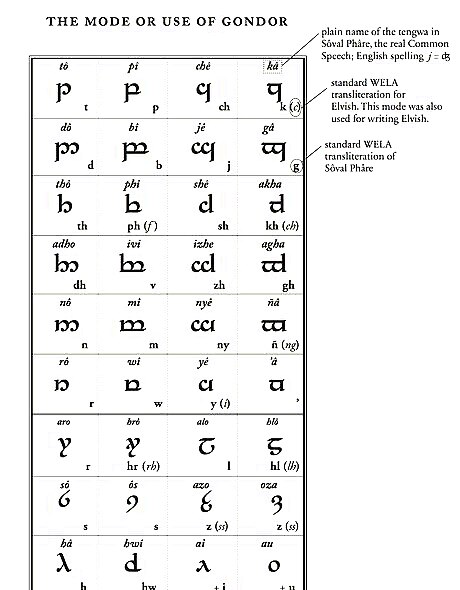
The table shows all the Tengwar that were commonly used in the West-lands in the Third Age of Middle-earth as explained by Tolkien in Appendix E of The Lord of the Rings. The arrangement is the one most usual at the time in the kingdom of Gondor. But the original Fëanorian alphabet consisted of a scheme of 24 signs representing consonants. To each consonant the vowel a was attached, as in the alphabet of Rúmil, the other vowels being represented by diacritic marks (usually placed above the consonantal sign). The writing ran from left to right.
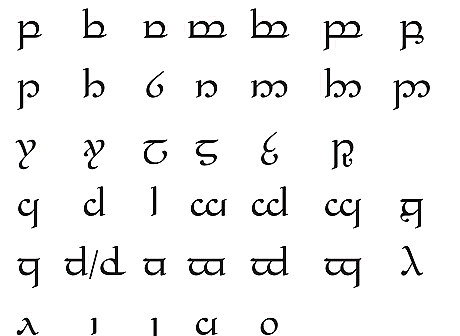
In the text "The Fëanorian Alphabet", Tolkien presented in what order the Elves, more specifically the Elves of the Second Clan, arranged and recited the Tengwar.

Learn the numbers. Tengwar can use either base 10 (decimal) or base twelve. It can also be written with the units first (so units, tens, hundreds etc, so 125 is five hundred and twenty one) or the more familiar units last (the way numbers are written in English). Usually, when using base 12, a dot is placed under the units digit. You can also place a dot or an overbar (not both) above every digit to make them stand out.
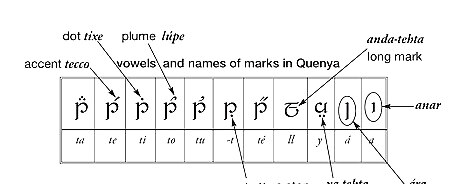
Learn the tehtar. Ancient modes of Tengwar had no letters for the vowels. Instead, they use diacritic marks, called tehtar, for the vowels. The vowels were variously represented. The usual system, especially with Elvish languages, or others of fairly simple vocalic system, was as follows: The sign like a dotless i was the vowel carrier: normally= a. The sounds i, e, o, u were denoted by diacritical signs as shown above.
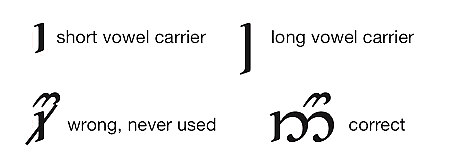
The placement of the tehtar varies: sometimes they are placed on the tengwa before them, other times the tengwa after them. If there is no tengwa in the appropriate place, then the tehta (singular of tehtar) is placed on a carrier. The short carrier is used for short vowels, the long carrier is used for long vowels.
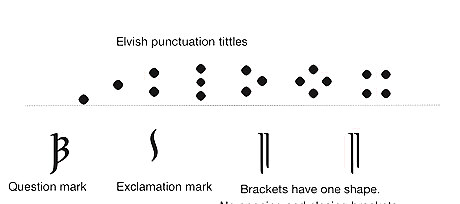
The punctuation. Each mode has its punctuation marks usage. The Elvish ‘punctuation tittles’ (max 4 dots) are not used exactly as the “European modern punctuation” but rather indicating pauses, the more of dots = longer pause. Texts written by Tolkien in natural languages (Latin, English, Old English) don't use the tengwar punctuation but standard English punctuation instead.
Writing in Quenya in the ára-tencele mode
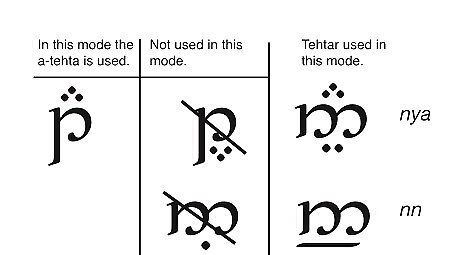
In this mode the tehta for "a" (3 dots above the tengwa) is universal and tengwar are not stopped. The vowels are placed on the tengwa before them. As explained by Tolkien, the ára-tencele mode is used for especially ornamental script or incised inscriptions. The poem "Namárië" as published in the book The Road Goes Ever On is written in the ára-tencele mode.
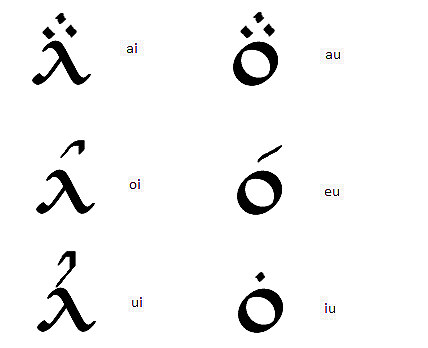
Learn how to write the diphthongs in ára-tencele mode. In all other vowel combinations, each vowel is pronounced and written individually.
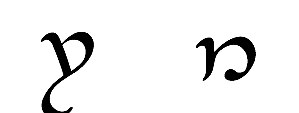
R rule.png Learn the R-rule. If you have an r followed by a vowel, use the left tengwa called rómen. If you have an r followed by a consonant or at the end of a word, use the right tengwa called óre.
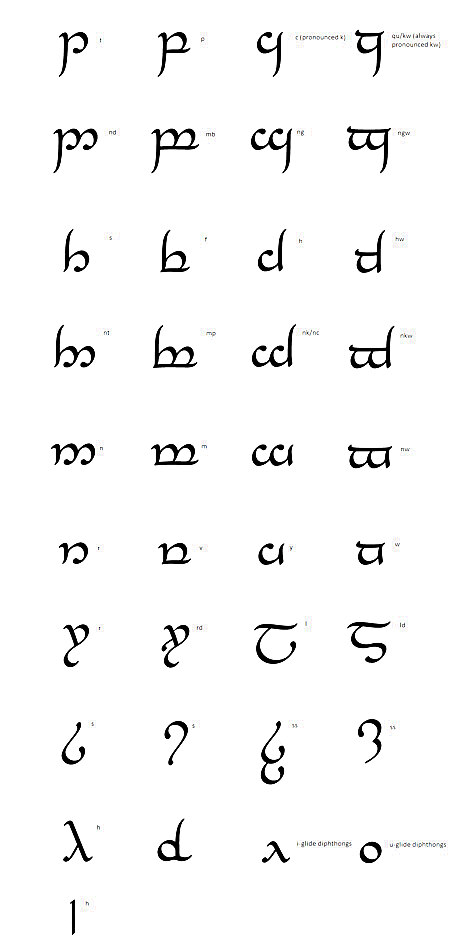
Learn the values of the tengwar. The table above gives the tengwar values for this mode.

Be aware that there are a few peculiarities in Quenya. Learn them well: The first tengwa called "thúle" later changed to "súle" in Colloquial Quenya. This tengwa is used for an s that developed from a th. E.g. súle was originally thúle. That change in pronunciation was opposed by the Elf Fëanor. Otherwise, for "s" use the second tengwa called "silme". The third tengwa "ñoldo" was used in Classical Quenya for ñ (like English ng in sing), later in Colloquial Quenya it was pronounced "n". The fourth tengwa "ñwalme" is only used initially (at the start of a word) in Classical Quenya, it had the value ñw. Later in Colloquial Quenya is was pronounced "nw". The fifth tengwa is called "anna" by Tolkien in Appendix E. It was used in Classical Quenya for the clear beginning or glottal stop initially (at the start of a word). Tolkien should have written " ’anna" in Appendix E as he did in other writings. Later this Tengwa became used as a carrier because the glottal stop disappeared. The sixth tengwa is used for a v that developed from a w. E.g. Vilya (Elrond's ring of power) was originally Wilya (meaning air), so it is spelt with this tengwa. The seventh tengwa called "halla" is used for independent "h". It is used in Classical Quenya for unvoiced initial r and l, hr, hl.
The Mode of Beleriand
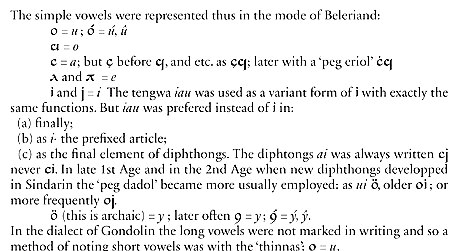
This is an alphabetical mode. The mode of Beleriand made use of some diacritical marks or 'teith' in Sindarin (see picture). It is one of the many "full writting" mode of the Tengwar.
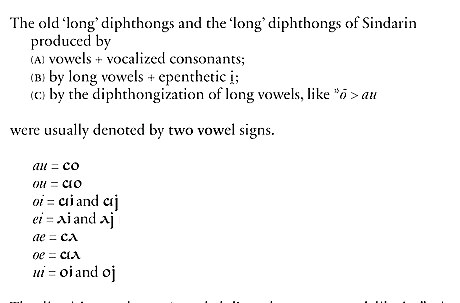
Learn how to write the diphthongs of Sindarin in the "mode of Beleriand".

Learn the letters written twice. In the mode of Beleriand, Sindarin long consonants are usually written twice (something which is not done in other modes), except with tengwa "númen" called in Sindarin "anno" used for nn, and "malta" called in Sindarin "ammui" mm, and "esse" called in Sindarin "esso" for ss. The correct way of writing each one in this mode is given above. The tengwa "áre nuquerna" is never used in the "mode of Beleriand" as explained by Tolkien.

Learn the values of the tengwar. The above table gives the values for this mode.
Know that Tolkien often used in Sindarin the Latin letter f for the sound v, as is traditional in English spelling. The river Lefnui is to be pronounced, and read levnui, and written levnui.
The Mode of Gondor

Learn the tehtar rule. In this mode the tehta is read first, then the tengwa. Therefore, vowels are placed on the letter after them.
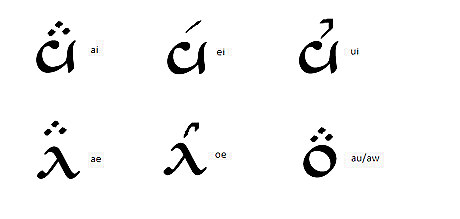
Learn the diphthongs. A diphthong is a pair of vowels pronounced as a single sound. All other vowel combinations are pronounced as individual vowels (I know that I'm repeating this in each method, but it's in case you've just skipped straight to this mode without reading the others).

Learn the double letters. Sindarin has four double letters: nn, mm, ll and ss. Note that the underbar is only used to double ll and ss.
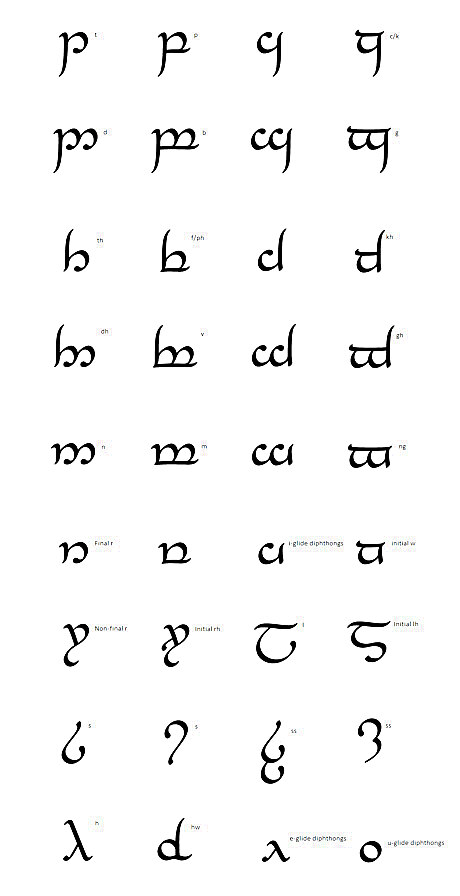
Learn the tengwar values. The above table gives the values for this mode.

Sindarin gondor step 5.png Bear a couple of things in mind: The left tengwar (v) is also used for a final f. The right tengwar (e-glide diphthongs) is also used for an initial i.
The One Ring inscription in the Black Speech
As only one piece of writing exists in Black Speech (the One Ring inscription) we do not know the values of all and every tengwar in this mode. We know it was an ancient mode of the Elves, maybe of Eregion, cfr. Gandalf in The Lord of the Rings : " ‘The letters are Elvish, of an ancient mode, but the language is that of Mordor, which I will not utter here." Tolkien really developed the Black Speech. This is what he wrote about this language: "The Black Speech was not intentionally modeled on any style, but was meant to be self consistent, very different from Elvish, yet organized and expressive, as would be expected of a device of Sauron before his complete corruption".

Learn the tehtar rules. The tehta is read before the tengwa. Therefore, vowels are placed on the letter after them. Tolkien wrote in Appendix E Lord of the Rings about this mode: "The curls were used for o and u. In the Ring-inscription the curl open to the right is used for u; but on the title-page {of The Lord of the Rings} this stands for o, and the curl open to the left for u." Note that it is an ára-tencle mode.
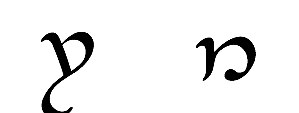
R rule.png Learn the R-rule in this mode. If you have an r preceded by a vowel and a tehta must be put on the r, you must use the tengwa called óre. If you have an r followed by a consonant and no tehta is needed the tengwa called rómen must be used.
Writing English using the Tengwar
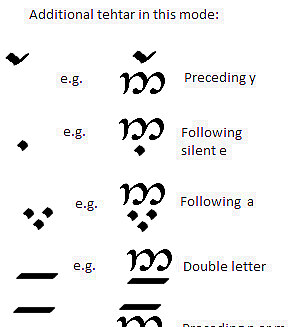
Learn the tehtar rule. The tehta is read before the tengwa. Therefore, vowels are placed on the letter AFTER them.
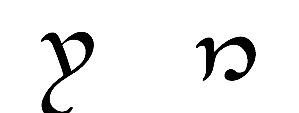
R rule.png Learn the R-rule. If you have an r followed by a vowel, use the left tengwa. If you have an r followed by a consonant or at the end of a word, use the right tengwa.
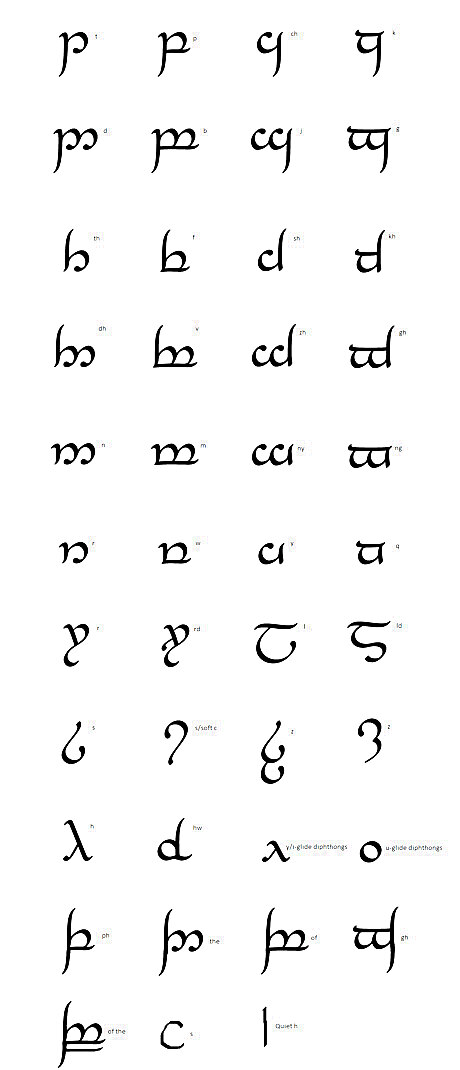
Learn the tengwar values. The above table shows the values for this mode.

Learn the peculiarities: The first tengwa represents kh as in loch and Christmas. Often the second tengwa is used instead. The third tengwa represents gh as in aghast and ghost. For gh as in bought, use the fourth tengwa. The fifth tengwa represents ny as in canyon, not as in pony. The sixth tengwa is usually used for a consonantal y, with the seventh being used as a vowel y. The eighth tengwa usually only appears in combinations such as ea in Earth.
How to practice?
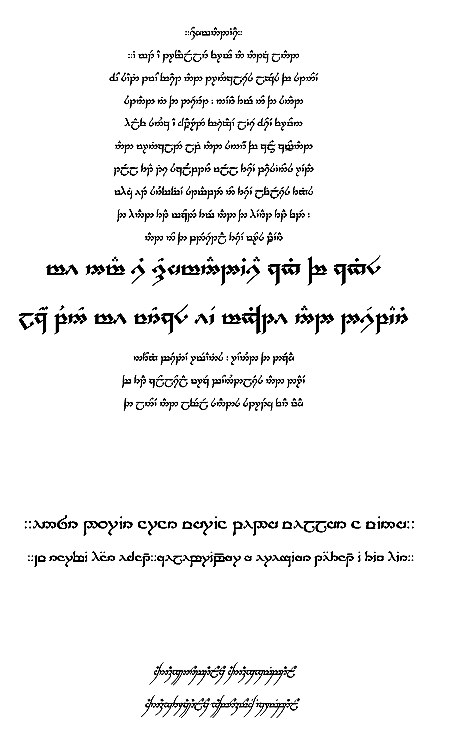
Try to read the texts written in Tengwar by Tolkien in The Lord of the Rings, in "The Road Goes Ever On", the 3 pages of Mazarbul, the poems in Tengwar in English in "Pictures by J.R.R. Tolkien". Do not start by reading fan writings in tengwar, that's not how you can learn.
Use it as much as possible. Write short words using tengwar (you can get tengwar fonts online if you want to use your computer). Don't try writing your homework in tengwar though - teacher won't be very impressed!


















Comments
0 comment